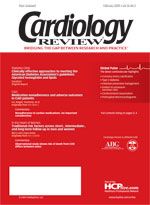Publication
Article
Cardiology Review® Online
Detection of anomalous origin of the coronary arteries-role of CT coronary angiography
Author(s):
In this issue, Schubert and Helenowski present a very dramatic instance of an increasingly common application of computed tomography (CT) coronary angiography—detection of an anomalous origin of the coronaries (page 40).
In this issue, Schubert and Helenowski present a very dramatic instance of an increasingly common application of computed tomography (CT) coronary angiography—detection of an anomalous origin of the coronaries. There is little doubt that CT coronary angiography is the optimal method at present for evaluation of this problem. Unlike invasive angiography, CT shows clearly and unambiguously the 3-dimensional relationships of proximal coronaries to other cardiac structures. Unlike cardiac magnetic resonance imaging (MRI), CT angiography provides uniformly excellent images in suitable patients and can be performed in a few minutes, whereas cardiac MRI for anomalous coronaries may take considerable time and repeated acquisitions.
Along with more effective detection of the problem, however, CT angiography also brings many unanswered questions that plague decision making and management, especially in asymptomatic patients without coexistent coronary stenoses. For example, even for those variants of anomalous origin most closely associated with sudden death, the natural history of asymptomatic anomalous origin and the prevalence and incidence of clinical or lethal events is unknown. Moreover, CT coronary angiography has begun to show many less clear-cut variants of anomalous coronaries, about which little at all is known. One example, seen relatively frequently in our CT angiography lab, is origin of the right coronary artery from the left anterior side of the aorta above the coronary sinuses, with the vessel then running vertically down in a crevice between the aorta and pulmonary artery/right ventricular outflow tract, in which the anterior surface of the coronary artery is clearly free, but the posterior wall could be subjected to pressure between the two great vessels. There are no reports of sudden death attributable to this anomaly to my knowledge, nor even any descriptive literature on it. Yet it is seen often enough in patients with seemingly cardiac complaints and no coronary stenoses to make one wish for good long-term data on natural history.
Another important feature of the anomalous coronary artery spectrum highlighted by this report is the susceptibility of some subtypes to development of proximal obstructive atherosclerosis. Again, a better understanding is needed of the natural history and long-term risks entailed when early atherosclerosis is found in such a vessel.
Because of the relatively low prevalence of coronary anomalies, it would take an extremely long time for any single center, however high the CT volume, to assemble data that really address these issues. Thus the need exists for a clinical registry that might provide sufficient cases and duration of follow-up to answer these questions. This is an ideal opportunity for the newly created Society for Cardiovascular Computed Tomography (SCCT) to take the lead in developing a platform for large-scale data collection. In so doing, the SCCT could lay the groundwork to address down the road many of the much larger and commonplace clinical challenges emerging in the field.






